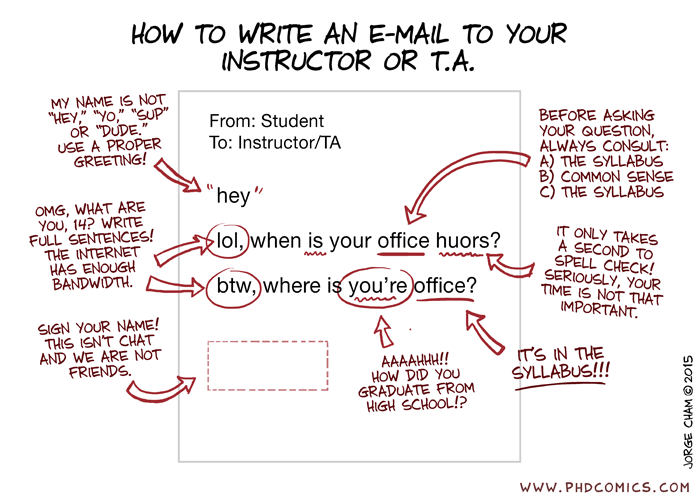I hold open office hours from 1045 to 1215 on Thursday mornings. You are welcome to drop in and see me then to discuss anything relating to the course. My office is G214a. I am also also in or around the office most mornings if I am not teaching, and some afternoons. Feel free to come and see me at any time, but be aware I may have appointments with other students or meetings to attend, or other work to do, outside of office hours.
If you want to see me but my office hours are not convenient, please email me at patrick.hart@bilkent.edu.tr to arrange an appointment. Attach your schedule so I can suggest a time we might both be free.
I’m also very happy to address any concerns or questions you have about the course by email (but do check first that your question isn’t answered in the course syllabus). However, one common complaint among professors at Bilkent and beyond is that many students do not write appropriate emails. Below is a short guide to emailing your professor, which will help you send emails that make the impression and get the response you desire, whether from me or from your other professors.
Emailing your Professor
Communicating ideas and information clearly and appropriately is a skill you will find useful not only on this course, but in your future academic and professional career, and in life more generally. One of the goals of this course is to help you develop your communication skills. How you present your ideas in exams and assignments is one way you can demonstrate these skills. How you write your emails is another.
If you have a question about your course, make sure that the information isn’t already available in the syllabus.
An email you send to your instructor should…
-
-
- have a helpful, relevant ‘subject’ line, such as ‘latest assignment’, ‘Final Paper’, or ‘attendance’;
- start with an appropriate greeting. In general, ‘Dear Prof. [surname]’ is appropriate. ‘Dear [first name]’ should only be used if your professor has told you this is acceptable. (I’m happy for you to call me ‘Patrick’ – this is me telling you this is acceptable!) The ‘Dear + [title] + [surname]’ form is a good habit to get used to, though. Note, too, that in academic life, it is polite to use people’s academic titles, so a full professor should be addressed as such (‘Prof. Stein’, for example), and anyone else with a PhD (most if not all of your instructors) should be addressed as ‘Dr.’ (e.g. ‘Dr. Williams’). Be especially careful to use appropriate academic titles for female academics: the dropping of women’s academic titles is much more common, and is often an example of (sometimes unconscious and unintended) gender bias.
- be written in complete grammatical sentences;
- explain clearly what you want from the professor, and supply any obvious extra information the professor will need. If asking for a meeting, it’s a good idea to attach your schedule, so they can suggest a time you will both be available. Avoid making unreasonable demands: polite requests are much more effective!
- include at the end of your email your full name and student number, and your course and section number. Your email should do this even if you have mentioned these in the body of your email.
-
If your email satisfies these conditions, you may normally expect a response within 24 hours, not counting Saturdays and Sundays. Otherwise, your email may be ignored at best.
Finally, if you are using an email address different from the one assigned to you by the University, make sure that your user name and email address are appropriate ones for academic and professional correspondence.
For more on emailing your professor, go here.
